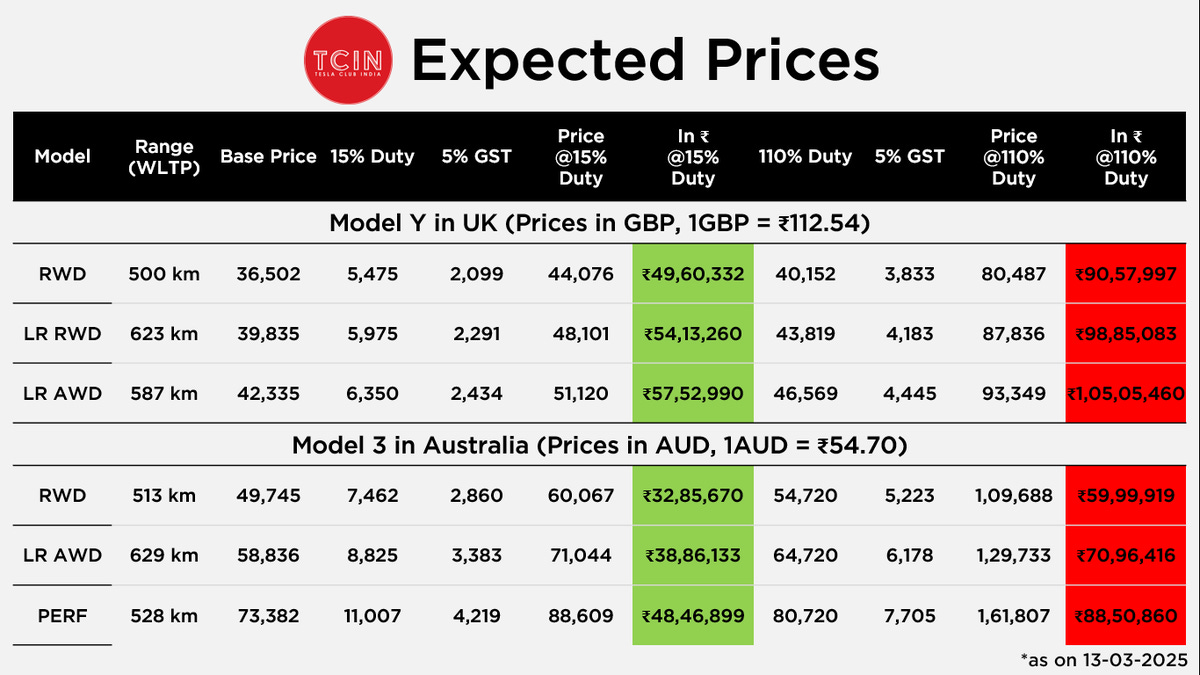This is a guest post by Nikhil Chaudhary.
Nikhil has been running Tesla Club India, an enthusiastic pan India not for profit EV community supporting all EVs and renewable energy. Nikhil has been running the community as a hobby for the past six years. Tesla Club India does deep research on the EV industry, asks the tough questions and supports community causes.
P.S. : I’ve been a co host of Tesla Club India’s podcast on the EV ecosystem. Check it out.
Housekeeping
It is less than 24 hours for you to get EVHardwareBI at a steal price! This charger intelligence tool allows you to understand the market trends and have numbers on your finger tips. Deep dive and understand your competitors and their strategy. The price goes up after 20th March 2025. Get it today.
You’ve probably heard the news by now, yet again. Tesla is finally a lot more serious to come to India. It’s been in the works for years, but 2025 might just be the year it finally happens.
This comprehensive 15 minute article will cover how Tesla’s approach towards production as well as selling the cars are different from other EV OEMs in India, what does SuperCharging network mean for Charge Point Operators and Charger OEMs, and other Tesla energy related offerings, for which the Government is releasing tenders at a rapid pace.
Tesla’s India rendezvous began in 2016 when they unveiled the highly anticipated Model 3, a car that revolutionized the EV industry. It was the electric car that made EVs accessible to the average consumer in the West. At the time, Tesla also opened reservations for India, requiring a $1,000 deposit. Many enthusiasts reserved one and nine years later, are still holding on to their bookings!
Since then, Tesla CEO Elon Musk has frequently promised Tesla’s entry into India - a handy timeline from 2015 to 2025.
The momentum to enter India picked up in 2021-22 when Tesla officially registered as an entity in the country. Multiple Model 3 and Model Y test cars were spotted on Indian roads. However, progress stalled due to high import duties. During this time, there were only five EVs in the Indian market - Tata Motors’ Nexon EV and Tigor EV, Hyundai’s Kona, MG’s ZS EV and BYD’s newly launched E6.
In April 2024, the Indian government introduced a new policy allowing automakers to import a limited number of cars at a reduced 15% duty, down from the usual 110-120%, for five years, provided they commit to local manufacturing. While the government is still finalizing the details, reports suggest applications for this policy will open in April 2025.
Will Tesla apply? We’ll get to that. But with duties currently at 110-120% and the new policy slashing them to just 15%, the price of an imported Tesla could be cut in half. Here’s some back of the envelope calculation:
But wait, there’s a new (old) president in the U.S., and he’s adamant about matching tariffs: You tax us, we tax you. Media reports have suggested that the Indian government is open to lowering tariffs in response. This sparked a frenzy of headlines speculating that Tesla would benefit.
But there’s a slight nuance here. Let’s first look at where Tesla models are currently manufactured:
Fremont (Mothership) – Model S, 3, X, Y
Giga Texas – Model Y, Cybertruck
Giga Berlin – Model Y (including Right Hand Drive - RHD)
Giga Shanghai – Model 3 & Y (including Right Hand Drive - RHD for both models)
See the issue? No? Okay, let’s break it down. Tesla no longer produces Model S & X in RHD, so those models are off the table. Cybertruck? That’s LHD (Left-Hand Drive) only, at least for now.
More importantly, RHD versions of Model 3 and Model Y are not made in the U.S. So, the whole tariff debate between India and the U.S. has no direct impact on Tesla's vehicle imports into India. The only way this could change is if Tesla shifts RHD production to a U.S. factory for a few days every few months which is a rare possibility, but worth mentioning.
Now, let’s focus on where Model 3 and Model Y RHD versions actually come from:
Model Y RHD – Manufactured in Berlin & Shanghai
Model 3 RHD – Manufactured in Shanghai only
Here’s the catch: Shanghai is in China. And it’s highly unlikely that the Indian government will drop tariffs on cars imported from China, unless they fall under the special EV policy. Otherwise, the market would be flooded with Chinese EVs, and, well… we all know how that would go.
So, if nothing changes on Tesla’s end, India is most likely to get only the Model Y, imported from Berlin provided there are no separate tariff negotiations between India and the EU. If such a deal happens, European automakers would also benefit.
What’s the only way Tesla gets reduced-duty imports into India?
By applying under the new EV policy.
If India negotiates a trade deal with Europe to lower car import duties.
Will Tesla apply under the new policy?
It’s hard to say. The policy requires a time-bound commitment, bank guarantees, and legal obligations that some automakers will find restrictive.
What about U.S. imports?
Unlikely to be an option.
And the price of Tesla in India?
No one knows yet. It is pointless to speculate before we get clarity on duties. You might have seen headlines about a ₹21L Tesla. That figure referred to Tesla’s upcoming new models, expected to launch in the first half of 2025 (as per their latest quarterly report). It was not referring to Model 3 or Model Y, but social media and WhatsApp groups ran with it anyway.
Tesla in India: What It Means for the Market
Let’s talk about what Tesla can bring to India and how it might impact the market. I’ll break it down to the best of my ability in the following sections.
You can also upgrade to a paid subscription by opting to pay via UPI.
Alternatively, you can share this post with your friends and colleagues. With their sign ups, you can get complimentary premium subscription to ExpWithEVs. 3 referrals get you 1 month subscription! Please be sure to use your referral link!
Keep reading with a 7-day free trial
Subscribe to ExperiencesWithEVs to keep reading this post and get 7 days of free access to the full post archives.





